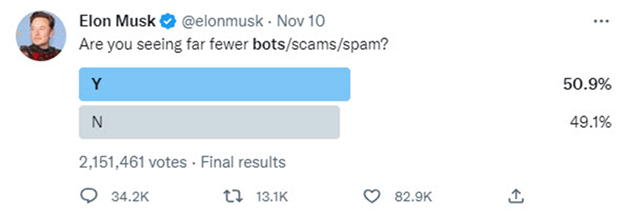LinkedIn Bots: Can You Trust the Most Trusted Social Network?

Bots and social media seem to go hand-in-hand, and no one made this more public than Elon Musk when he declared war on bots as part of his plans for Twitter, then cited the excess of spam accounts as his primary reason for trying to get out of the $44 billion deal.
Fast forward to the present day, and well, Elon is clearly still concerned about the amount of bots, spam accounts, and as a result, ad fraud.

This article isn’t about Elon, Twitter, or even SpaceX. Today we are calling attention to the prevalence of bots in social media, specifically one you might not consider day-to-day, LinkedIn. Traditionally a social tool for the professional community with more than 875 million members and 58 million registered companies, people use LinkedIn to network, build connections, search for jobs, and join like-minded groups. LinkedIn is a behemoth in the social platform space and a leader in providing qualified leads to businesses, and not just folks for a company’s HR team to recruit. A virtual gold mine of B2B leads, it also boasts the highest conversion rate, nearly three times that of other sites. Also in its favor, LinkedIn scores high in the perception of legitimacy with 69% of people trusting the platform not to show deceptive content.
However, bots are wreaking havoc everywhere—including LinkedIn. Public scrutiny of the network grew last month when the site dropped 7-10 percent of all profiles, including a significant purge of members who claimed they worked for Apple and Amazon. Krebs On Security reported that “On October 10, 2022, there were 576,562 LinkedIn accounts that listed their current employer as Apple Inc. The next day, half of those profiles no longer existed.” Clearly, LinkedIn is struggling to keep up with fraudulent activity, specifically fake employee accounts that pair AI-generated profile photos with text lifted from legitimate users. In other words, scammers.
So, can you trust them?
With LinkedIn making headlines as bots appear to take hold in this powerhouse tool for professionals, they are trying to combat the issue. Their transparency report claims their teams and automated systems are stopping the vast majority of fraudulent activity, around 96% of fake accounts and approximately 99.1% of spam and scam content. At the same time, the technology behind the nefarious activity continues to evolve in its sophistication. This is a problem since LinkedIn is the self-proclaimed“leader in B2B digital advertising” relying on advertising dollars, dollars spent by companies looking to promote their products and services to real-life human beings—not bots or scammers. These fake profiles don’t just stop at the company level; Krebs On Security also reported there were a significant number of accounts created to replicate specific job titles, infiltrate groups, and inflate LinkedIn numbers.
More Can Be Done to Combat Bots
How do bots click on my ad? Great question. They use software (aka bots) to run those workflows. The software is so sophisticated it can even like your posts, look at your account, endorse a skill, and more. These same workflows will click on your ad, engage in your posts, and inflate false traffic, engagement, leads, hopes, and dreams.
While self-regulation is a step in the right direction, there are currently no standards or regulations in place for digital advertising platforms to be held accountable for combating ad fraud. There are also no checks and balances. And what incentive do social networks have to lower audience sizes when advertisers base their spend on measurements like pay-per-click? We recently wrote a blog post about whether ad platforms are incentivized to reduce ad fraud. You can read more about it here,or we will give you the CliffsNotes version; they aren’t.
The High Cost of Fraud
Aside from worrying about the money wasted on bots, scammers also use LinkedIn’s messaging service to commit investment fraud. The problem even prompted the FBI to issue a warning when people reported losing their life savings. Individuals in one victim group lost anywhere between $200,000 to $1.6 million each!
To their credit, LinkedIn is rolling out new tools designed to give users more information as they navigate the platform, starting with profile and message features. For example, with the introduction of the “About this profile” feature, a profile will show when it was created and last updated and if there is a verified phone number and/or work email tied to it. (Email verification is slowly being rolled out with select companies and will expand over time.) LinkedIn may also issue message warnings highlighting when you are being asked to take the conversation to another platform as it could be a sign of a scam. Then again, it is also a way to keep users engaged on their platform as much as possible.
If you’re approached by someone you don’t know on LinkedIn with a deal that sounds too good to be true… you know how it goes.
Avoid fake profiles by examining a few key details:
1. Use a reverse Google image search on profile pictures to see if they are being used elsewhere.3. Check their posts for signs of authentic engagement; are they sharing things without commenting, or are they interacting with other people’s posts?
4. Look at their networks to see if they have more than 100 connections and if you share any in common.
If you believe an account might be fake, be a good steward of the community and report it.
Don’t Wait for Help When There’s Already a Solution
With our experience scanning LinkedIn campaigns, we’ve found using our Search and Social Protect™ product that, on average, 25% of LinkedIn traffic is fraudulent. This is a much higher number than what LinkedIn has claimed in its transparency report. And as a marketer, your ad spend is probably closely tied to the related ROI. But if a proportion of your ad spend is wasted on false leads, it skews your performance numbers and negatively impacts overall revenue. 25% is a large amount of the marketing budget to throw down the drain.
When you receive a connection request from someone you don’t know on LinkedIn, how do you know who to trust? How do you know if the clicks on your campaigns are legitimate? Besides the obvious hit to your marketing budget, there are many reasons why combating bots is critical to your business. As bots proliferate on every platform, Anura can help.
Fighting Ad Fraud Is Everyone’s Burden
Anura provides an independent ad fraud solution that can provide you with the data you need to make informed decisions about your advertising campaigns. In addition, an independent ad fraud solution can help you save money by preventing you from paying for fraudulent traffic.
Anura is a TAG-certified ad fraud solution that helps you stay proactive in preventing ad fraud across all your ad platforms. It detects fraud with 99.999% accuracy, so you can have peace of mind when deciding what advertising channels to use or asking for a refund from a platform provider.
Explore how Anura’s features helpyou eliminate wasted ad spending to maximize your return on investment (ROI). Contact us todayto schedule your free trial.


